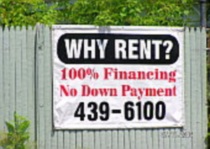Use notes to buy tax sale property. Post 206.
 Mitch Goldstein | Coach Mitch | August 6th, 2014
Coach Mitch’s REFLECTIONS™
[Editor’s Note] A student asks about structuring a promissory note.
Coach Mitch,
Hypothetical scenario,
when a tax delinquent homeowner agrees to transfer the property’s responsibility to me, title included, how should a promissory note be structured? Should the amount of the note be the tax amount that has been paid by the investor, plus interest? Or should it include the tax amount paid + sell back / transfer back price? I know that there are many different types of ways to structure a pay back, but I would like your feedback or recommendation on best practices.
Answer:
There are several levels of purchases: Retail, Wholesale, Firesale, and Give-A-Way.
When I think of “buying” I mean using your own money, your savings. If another investor is satisfied with putting up their monies at 75%+ of retail, then do it. I never have used my own money for any property over 50% Fair Market Value.
You can option at Retail, but you never purchase at retail, which I define as 80-90+% of Fair Market Value. You also never pay Wholesale, 65-75% of FMV. You can look at Firesale property, 40-50% FMV, but you try to buy at Give-A-Way prices, 10-20% FMV.
Homerun
The best way to consistently speak with those who may give-a-way their property are those whom you’ve captured in “The Vice.”
The biggest consideration is to find desperate sellers and to give the seller what they need. After that, you can request that you get what you need. If the sellers “need” a certain number, then give it to them, but in a way that you can make a profit.
The ways to give them their price but in a way that you can make a profit becomes more clear if knowing Time Value of Money calculations. Teach yourself at: The Time Value of Money Calculator
Back in 1985 I purchased a HP12C financial calculator for $65, which I still use. Ebay currently has them selling for $63. I spent a weekend reading, learning and attempting calculations. I still remember being fascinated by learning about a concept called a Time Line. Learning about the five basic financial values and how to manipulate them was a signature moment. My salesmen were astounded when I showed them how to use the calculator to pre-qualify people for mortgages and how to do deals by discounting notes.
After almost 30 years, I can now approximate calculations in my head, but my HP12C is always close by.
The way it is –
People always want their money in a full lump sum, but they will often take a smaller lump payment and a periodic payment. You have to drag out of them the reasons they need the funds and then figure how to accommodate their need.
A BIG trick, try to make differing calculations result in the same ROR.
Example:
1. A proposed promissory note: 60m term, 10% interest rate, $10000 note, $212m payment.
2. However the sellers want more money. You say OK, but you need to pay your way: 84m term, 5% interest, $15000 note, $212/m payment.
3. The seller wants even more money. OK, your new proposal is: 95m term, 0% interest, $20000 note, $212/m. Voila!
The same concept can be done if the seller wants a higher interest rate. You manipulate any of the other values to make the calculation come out the way you want. The seller thinks he is getting his higher interest rate and you are getting a deal – in a way that you can make a profit.
Time Value Of Money
The central idea is that money loses value over time, due to inflation, opportunity cost and other real world issues. That is to say, money in your hand today is worth more than money that you may receive over time, and the more distant the time, the less valuable the money is perceived to be and therefore the higher the interest rate that must be gotten to accomplish the rate of return that you need.
The Note
The paperwork is all the same excepting the numbers.
A Promissory Note is straight forward; you say you promise to pay with the following terms and fill in each value, i.e. term, interest, principle, payment, and future value. You sign and notarize the document and you’re done.
Once you have learned to use either the HP12C or the Texas Instruments BA II Plus, even a little bit, you will become VASTLY more powerful as a negotiator. Others will argue going from $10000 to $20000. Not you; you just say, “Yes.” Coach Mitch always says, “Yes.” Then figure out how to do it. If you can’t do the figuring, call me and we’ll do it together. You just say, “Yes.”
Serendipity
Once the idea of the note is accepted, be sure to add clauses that will come in handy in the future. Be sure to have a Right of First Refusal, so if the seller wants cash now, that you have the ability to buy first. You can also have a Pre-Payment Foregivness clause, where you get a discount if you pay off the note early.
Be empathetic, be creative, be assertive –
|
Complimentary Report
10 Ways Coach Mitch's "Ridiculously Simple System..." Is An Extraordinarily Profitable Way To Invest

Ellis, you are Exciting Dear Coach Mitch,
I got the list of tax delinquent properties exactly how he explained to get it, and found the ones that didn't have any mortgages and not many liens.
I found one property I really wanted to pursue, so I drove by the house and saw it was vacant and talked to a neighbor sitting outside who had the owner’s number. I called the owner that night and asked what was her plan with the property. She signed the deed over to me for just a one dollar.
I started marketing the house that day and it was sold after two days on the market for $12,000 with me only investing one dollar.
The following week I found another property on the list of tax delinquent property that was vacant, up for auction and also free and clear of any mortgages with just a $600 lien on the property. I called the owner and asked what was her plans for the property. She stated she didn't want the property. I told the owner I would take full responsibility for the property. She asked what was in it for her? I said one hundred dollars and she agreed; I will be closing next week.
Coach Mitch’s program really works.
Ellis Davis St. Louis, Missouri
Ken – make it happen!
Hi Coach Mitch,
Thanks, that postcard template is a brilliant idea. The new strategy really puts us ahead of the curve. I can picture the seller thinking a developer has money and is willing to pay top dollar without any extensive haggle.
Yet, they most likely will still be willing to negotiate if need be. I really like your series of strategies to get the seller to lower the price if they get obstinate.
The new post card format and verbiage seems great. The sales message is very powerful.
That’s awesome work Coach Mitch!!!!
Best,
-Ken Barns, Oxnard, CA
TY Adam Coach Mitch,
This message is to say THANK YOU! Sincerely, I'm amazed by you. The time and energy you have invested in my personal growth goes far beyond anything I ever expected.
I've been wholesaling for nearly two years now and bought into so many programs by this point I couldn't even count them all. Coach, I love calling you Coach because that's what you truly are for me. I don't know if you realize this, but you just took a couple hours to role play with me and help me feel confident when talking with sellers!?!
Thank you for your commitment to my excellence in this business and as a person. It shines through in all that you do and all that you stand for. You're patient guidance through all this is changing my life, my family's life, and my new client's lives. I got into this business to do good and really make a difference for people. You are helping with an arsenal of tools for me to carry this forward. I briefly mention to other wholesaler friends what I'm doing, and no one has a clue and these are some big time guys.
What you're teaching me is a goldmine!!! Coach, thank you for guiding me through making my dreams a reality. I am a better person because I know you. You are a part of the solution. I am grateful.
ALL THE BEST!
Adam C. Stoker St. Louis MO
Delighted by Lynn
Working with and getting mentored by Coach Mitch has been a wonderful experience. I have learned so much about real estate from him, as he has such a wealth of knowledge.
He is always accessible whenever I have a question or need clarification of any sort. He is actually one of the most accessible coaches I've ever worked with. In addition, he is willing to work through various scenarios with you. I have to say some of the ideas he comes up with in our brainstorming sessions are the best!
I have become more confident in real estate and I know I have a business partner in Coach Mitch.
Lynn Lawson
Atlanta, Georgia
Juan, you’re great! I bought Mitch Goldstein 's Tax Lien Course two months ago and found his material very complete and very detail oriented.
His support was amazing. Any questions that I have, I just call him and got his response immediately. I have worked with several Real Estate Professional Coaches before and in addition to their high cost of the material they never have the time to support you.
Mitch has a well-deserved reputation for expertise, support, and professionalism in all stages of the Tax Lien/Tax Deed process.
Just to mention my last experience with him, he just spent 1 hour and a half explaining how to use my computer in a step by step process on how to find and analyze the information from the Hillsborough Court Clerk at Tampa Florida.
I would be very happy to recommend him to anyone interested in the Tax Liens and Tax Deed Investments. His in depth KNOW HOW and support, place him in an enviable position as a Real Estate Coach.
Juan Moises Mejia
Tampa, FL
WoW! Thanks a lot Jim Coach Mitch,
I like your style. Out of all the people I've listened to talk and all the people I've thought that were going to help me, you're the one. I just love your style. I loved your answers. The other night was the first time I ever heard you and I can't say it more. I was impressed with you. You had the answers.
I was nervous because I don't want to mess up the first call. But you said, "If you mess up the first one, don't worry about it, there are plenty more leads. If you mess up the first ten, don't worry about it, there are plenty more leads, thousands more." That's when I felt more relaxed.
I'm just so excited now. With everything I've been through, I feel I can make a turnaround with my life. I'm looking forward down the road and I just wanted to say - thank you.
Jim Misiora - Taylor, Michigan
Thank You Carl, see you at the top. Hello Coach,
Just wanted to thank you for being a responsible and stand-up guy. Since I first purchased your $1 option program, you have made yourself available to answer all my questions and concerns. You have gone over and above, in my opinion, to make sure that I stayed on point to accomplish my goals.
I will not hesitate to recommend you to anyone, at any time.
Thank you for the information you sent last night.
God Bless,
Carl Smith, Maryland
TY Jim – You’re great!. OK. I've been dealing with gurus and using their techniques. This is the first one that I am so excited about...especially the $1 Option.
If I may say so, I've never seen options explained like that. A $1 Option seems a little far fetched, but when I read this thing, I realize that it is as real as the telephone I have in my hand right now. This is a very good manual. This is a fantastic manual. It is powerful, very, very powerful.
James Harrison. - Phoenix, Arizona
excerpted from Post #3
Thanks James, you’re easy to work with. Dear Coach Mitch,
When I first heard you outline your “RIDICULOUSLY SIMPLE SYSTEM”, I was literally pacing my living room in excitement!
For years I have gone to several other seminars, bought all the tapes and even done boot camps only to have limited or no success. It seems like I was always missing something?
Well, this is exactly what I have been looking for. You are available to me one on one and your teaching style is engaging and informative. This education is worth every penny. I feel like all my past efforts were leading me to this point and I am confident that having my own personal coach will prove to be the best investment I could make!
Thanks for everything!
J. S Cocoa, FL.
Gloria, I’m glad you’re glad!
Hi Coach Mitch,
Thanks for the help I have received thus so far. I'm having a life-changing, God blessed experience since receiving your material on 10/24/13.
I didn't think I could comprehend the material because I truly know nothing about REI but, you explained the material in a plain and simple manner, like teaching A,B,C.........Z in a superb manner!
Thanks for sharing this whole new world with me. I am confident that it will have a dramatic affect in my life and the lifestyle and future of my family.
Thank - you Coach Mitch,
Gloria Karungi Detroit, MI
Right On Rick! Coach Mitch,
Just a quick note. Last night I came across some of your old newsletters. You are Really "On Top" Of Your Game...especially the one from October 14, 2008. What you were saying then...is today's news Now! You might enjoy going back and looking over it again yourself.
Your friend
Rick Ward in Lubbock Texas
|








Leave a Reply